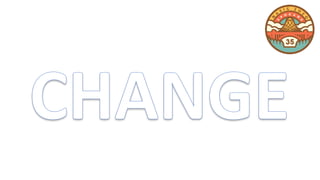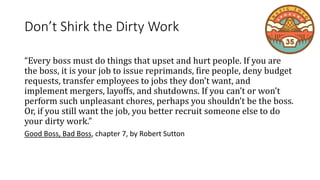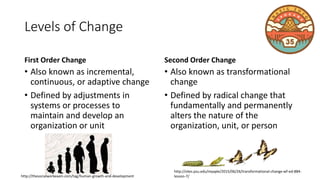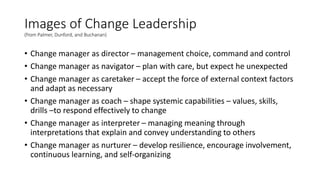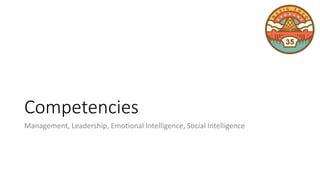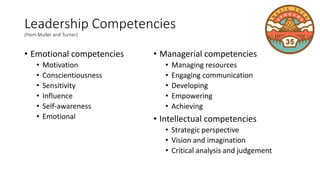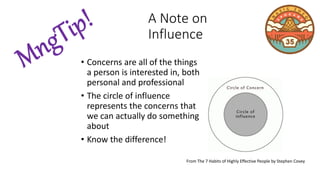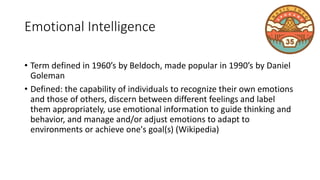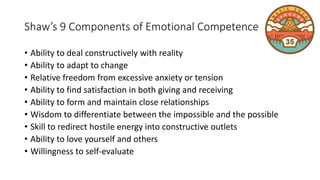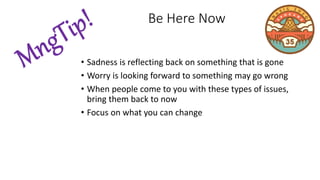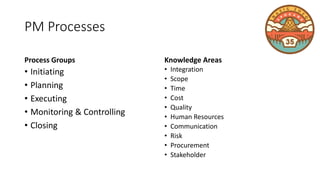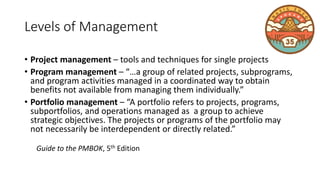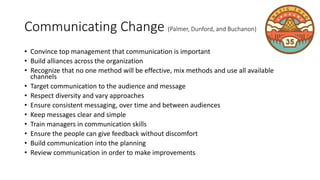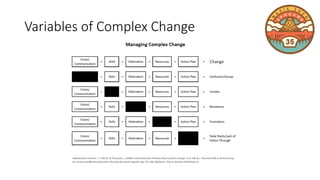Mapping Domain Knowledge for Leading and Managing Change
- 1. Mapping Domain Knowledge for Leading and Managing Change Janetta Waterhouse University at Albany June 2020
- 8. Domain Knowledge • Our domain is library services • Technical services • Acquisitions • Serials • Cataloging • Electronic resources
- 9. What does it take to be successful • As a leader • You don’t have to be a manager to be a leader • As a change agent • As a project manager
- 10. General and Domain Knowledge • Management • Leadership • Change Management • Project Management
- 11. Mapping Domain Knowledge Leadership, Change Management, Project Management
- 12. Management • Communication • Active listening • Time management • Productivity • Team building • Diversity, equity, inclusion • Performance management • Process management
- 13. • All of it • Performance Management is essential • It’s not about being nice versus not nice • Giving feedback is necessary • And it gets easier the more you do it Do Your Job
- 14. Don’t Shirk the Dirty Work “Every boss must do things that upset and hurt people. If you are the boss, it is your job to issue reprimands, fire people, deny budget requests, transfer employees to jobs they don’t want, and implement mergers, layoffs, and shutdowns. If you can’t or won’t perform such unpleasant chores, perhaps you shouldn’t be the boss. Or, if you still want the job, you better recruit someone else to do your dirty work.” Good Boss, Bad Boss, chapter 7, by Robert Sutton
- 15. Be prepared • Understand the difference between performance problems and disciplinary issues • Use your human resources performance evaluation process • Make sure the position description and related skill, behavioral, and supervisory competencies are clearly defined • Make sure personnel within your unit or project understand the expectations • Know your human resources progressive discipline process
- 16. Change Management • A collective term for all approaches to prepare, support, and help individuals, teams, and organizations in making organizational change. Wikipedia • An approach to transitioning individuals, teams, and organizations to a desired future state • “Globalization and constant innovation of technology result in a constantly evolving business environment” • From Architecting Enterprise: Managing Innovation, Technology, and Global Competitiveness by Rajagopal
- 17. Kotter’s Eight Step Process • Create a sense of urgency • Build a powerful guiding coalition • Form a strategic vision and initiatives • Enlist a volunteer army • Enable action by removing barriers • Generate short-term wins • Sustain acceleration • Institute change • From https://www.kotterinc.com/8-steps-process-for-leading-change/ • See also Leading Change: Why Transformation Efforts Fail by John Kotter. Harvard Business Review, January 2007
- 18. Kubler-Ross Change Curve • A model that focuses on the emotional responses of the people affected by change • People will move through the process in various ways at various times https://visibleprocrastinations.wordpress.com http://en.wikipedia.org/wiki/Change_management
- 19. Lewin’s Change Model • Three stages of change • Unfreeze – prepare the organization to accept necessary change; this is usually the most difficult and stressful part of the process • Change – begin to resolve uncertainty and look for new ways to do things; Time and communication are the two keys to the changes occurring successfully • Refreeze – afterward, when people have embraced the new ways of working, internalize changes; celebrate success of the change • https://www.mindtools.com/pages/article/newPPM_94.htm
- 20. Dimensions of Change • Drivers • Internal, external • Types • Organizational, technological, cultural • Levels • Incremental, transformational
- 21. Levels of Change First Order Change • Also known as incremental, continuous, or adaptive change • Defined by adjustments in systems or processes to maintain and develop an organization or unit Second Order Change • Also known as transformational change • Defined by radical change that fundamentally and permanently alters the nature of the organization, unit, or person http://sites.psu.edu/myaple/2015/06/26/transformational-change-wf-ed-884- lesson-7/http://thesocialworkexam.com/tag/human-growth-and-development
- 22. Implementation Differences Incremental Change • The destination is known • Steps to get there are known and can be determined in advance • Improves or adapts rather than creates new Transformational Change • Exact destination is unknown • Change strategy employed but change process emerges over time • Alters leadership and culture in significant way https://www.pinterest.com/pin/201817627022555543/ http://ztbigtrip.blogspot.com/2013/06/a-week-in-norway.html
- 23. • A common reason people resist change is that the expertise they have built is being set aside • They will learn new skills • But they are also likely to make mistakes • If your organization has a culture of perfection, let people know it’s OK to take risks Risk Tolerance
- 24. Leadership • Getting work done through other people; motivating others to accomplish work directed toward a goal • According to Kotter: “…more change demands more leadership, which places managers in more complex webs of interaction” • According to DuBrin: leadership can be expressed as a formula L = f(l, gm, s) where leadership is a function of the leader (l), group members (gm), and other situational variables (s)
- 25. Leadership Theories/ Schools (from Muller and Turner) • Trait – effective leaders are born, not made • Behavior – effective leaders adopt certain styles or behaviors; leadership skills can be developed • Task-oriented – accomplishment of shared objectives • Relationship-oriented – increasing coordinated engagement of the team members (Behrendt, Matz, and Goritz) • Contingency – what makes an effective leader depends on the situation • Visionary/charismatic • Transactional – concern for process • Transformational – concern for relationships
- 26. Leadership Theories/ Schools (from Muller and Turner) • Emotional Intelligence • What differentiates leaders is their emotional response to situations • Emotional Intelligence has a greater impact on performance than intellect • Competency • Effective leaders exhibit certain competencies, including traits, behaviors and styles • Different profiles of competence are better in different situations
- 27. Variations on Leadership Theories • Authentic leadership • Complexity theory of leadership • Adaptive leadership • Servant-based leadership • Participative leadership • Strengths-based leadership
- 28. • When we move up from technical areas, we may think we should have all the answers • What’s more important is to know that the answer is in the room • You must get the right people together • You must make sure everyone gets the chance to talk and is heard The Answer is in the Room
- 29. Images of Change Leadership (from Palmer, Dunford, and Buchanan) • Change manager as director – management choice, command and control • Change manager as navigator – plan with care, but expect he unexpected • Change manager as caretaker – accept the force of external context factors and adapt as necessary • Change manager as coach – shape systemic capabilities – values, skills, drills –to respond effectively to change • Change manager as interpreter – managing meaning through interpretations that explain and convey understanding to others • Change manager as nurturer – develop resilience, encourage involvement, continuous learning, and self-organizing
- 30. Competencies Management, Leadership, Emotional Intelligence, Social Intelligence
- 31. Management Competencies (from Yukl) • Supervising • Planning and organizing • Decision making • Monitoring indicators • Controlling • Representing • Coordinating • Consulting • Administering https://www.toppr.com/guides/business-studies/principles-of- management/concept-of-principles-of-management/
- 32. Leadership Competencies (from Muller and Turner) • Emotional competencies • Motivation • Conscientiousness • Sensitivity • Influence • Self-awareness • Emotional • Managerial competencies • Managing resources • Engaging communication • Developing • Empowering • Achieving • Intellectual competencies • Strategic perspective • Vision and imagination • Critical analysis and judgement
- 33. • Concerns are all of the things a person is interested in, both personal and professional • The circle of influence represents the concerns that we can actually do something about • Know the difference! A Note on Influence From The 7 Habits of Highly Effective People by Stephen Covey
- 34. Emotional Intelligence • Term defined in 1960’s by Beldoch, made popular in 1990’s by Daniel Goleman • Defined: the capability of individuals to recognize their own emotions and those of others, discern between different feelings and label them appropriately, use emotional information to guide thinking and behavior, and manage and/or adjust emotions to adapt to environments or achieve one's goal(s) (Wikipedia)
- 35. Components of Emotional Intelligence Self Management • Self awareness • Self regulation • Motivation Relationship Management • Empathy • Social skill
- 36. Components of Emotional Intelligence (Goleman; Bradberry and Greaves) • Self awareness – the ability to recognize and understand your moods, emotions, and drives, as well as their effect on others • Self regulation – the ability to control or redirect disruptive impulses and moods; the propensity to suspend judgment – to think before acting • Motivation – a passion to work for reasons that go beyond money or status; a propensity to pursue goals with energy and persistence • Empathy – the ability to understand the emotional makeup of other people; skill in treating people according to their emotional reactions • Social skills – a proficiency in managing relationships and building networks; an ability to find common ground and build rapport
- 37. Shaw’s 9 Components of Emotional Competence • Ability to deal constructively with reality • Ability to adapt to change • Relative freedom from excessive anxiety or tension • Ability to find satisfaction in both giving and receiving • Ability to form and maintain close relationships • Wisdom to differentiate between the impossible and the possible • Skill to redirect hostile energy into constructive outlets • Ability to love yourself and others • Willingness to self-evaluate
- 38. Goleman’s Leadership Styles • Coercive • Authoritative • Affiliative • Democratic • Pacesetting • Coaching • “The more styles a leader has mastered, the better. In particular, being able to switch among the authoritative, affiliative, democratic, and coaching styles as conditions dictate creates the best organizational climate and optimizes business performance”
- 39. Social Intelligence • The capacity to know oneself and to know others Wikipedia • Important for effective teams: Good teams succeed because of how they treat each other • Smarter, Faster, Better by Charles Duhigg • Social intelligence test: http://socialintelligence.labinthe wild.org/mite/
- 40. • Sadness is reflecting back on something that is gone • Worry is looking forward to something may go wrong • When people come to you with these types of issues, bring them back to now • Focus on what you can change Be Here Now
- 41. Project Management • “Temporary endeavor undertaken to create a unique product, service, or result” Guide to the PMBOK • Multiple approaches • Traditional waterfall, agile, hybrid • Triple Constraint • Scope, Time, Cost
- 42. PM Processes Process Groups • Initiating • Planning • Executing • Monitoring & Controlling • Closing Knowledge Areas • Integration • Scope • Time • Cost • Quality • Human Resources • Communication • Risk • Procurement • Stakeholder
- 43. Levels of Management • Project management – tools and techniques for single projects • Program management – “…a group of related projects, subprograms, and program activities managed in a coordinated way to obtain benefits not available from managing them individually.” • Portfolio management – “A portfolio refers to projects, programs, subportfolios, and operations managed as a group to achieve strategic objectives. The projects or programs of the portfolio may not necessarily be interdependent or directly related.” Guide to the PMBOK, 5th Edition
- 45. Communication
- 46. • Conflict in a natural part of life • It can be managed in a healthy way • It should not be the case that the most emotional person gets his or her way Rethink Conflict
- 47. Common Perception of Conflict •Conflict Avoidance Confrontation
- 48. Ideal Process of Managing Conflict •Conflict Negotiation
- 49. Communication Channels • Push – send information to people (email distribution lists) • Pull – provide a place for people to find information (wiki, staff intranet, online guide) • Interactive – in-person meetings, a chance for people to hear and interact
- 50. Communicating Change (Palmer, Dunford, and Buchanon) • Convince top management that communication is important • Build alliances across the organization • Recognize that no one method will be effective, mix methods and use all available channels • Target communication to the audience and message • Respect diversity and vary approaches • Ensure consistent messaging, over time and between audiences • Keep messages clear and simple • Train managers in communication skills • Ensure the people can give feedback without discomfort • Build communication into the planning • Review communication in order to make improvements
- 51. Communicating Change (from Palmer, Dunford, and Buchanan) • Resistance to Change • There are many reasons people may not be interested in change • Some may be based on past experience • Some may seem unlikely or irrational • The key is to listen and translate • Attraction Strategies • There are many suggestions you can use to encourage participation in change efforts • Empathy and communication go a long way • Remember that people won’t often know how to identify the real problem
- 52. Resistance to Change (from Palmer, Dunford, and Buchanan) • Innate dislike of change • Low tolerance of uncertainty • “This is not in my interests” • Attachment to organization culture and identity • Perceived breach of psychological contract • Lack of conviction that change is necessary • Lack of clarity as to what is expected
- 53. Resistance to Change (from Palmer, Dunford, and Buchanan) • Belief that the proposed changes are inappropriate • Perception that the timing is wrong • Too much change • Cumulative effects of other life changes • Perceived ethical conflict • Legacy of past changes • Disagreement with how change is managed
- 54. Attraction Strategies (from Palmer, Dunford, and Buchanan) • Allow room for participation in the planning of the change • Leave choices within the overall decision to change • Provide a clear picture of the change, a “vision” with details about the new state • Share information about change plans to the fullest extent possible • Divide a big change into manageable and familiar steps; let people take a small step first • Minimize surprises; give people advance warning about new requirements • Allow for digestion of change requests- a chance to become accustomed to the idea of change before making a commitment
- 55. Attraction Strategies (from Palmer, Dunford, and Buchanan) • Repeatedly demonstrate your own commitment to the change • Make standards and requirements clear – tell exactly what is expected of people in the change • Offer positive reinforcement for competence; let people know they can do it • Look for and reward pioneers, innovators and early success to serve as models • Help people find or feel compensated for the extra time and energy change requires • Avoid creating obvious “losers” from the change; if there are some, be honest with them early on • Allow expressions of nostalgia and grief for the past, then create excitement about the future
- 56. Variables of Complex Change
- 57. • Getting buy in is important • But at some point you may need to just take action • Understant the emotion – cognition – behavior connection • Consider working backwards Take Action
- 58. Develop Skills for Change • Work on your emotional intelligence • Understand your leadership style • Develop your leadership behaviors, competencies & know when to use different competencies • Make your own peace with change • Be here now • Identify change resistance or variables in others • Have positive change narratives • Recognize even the smallest change • Communicate appropriately for the individual or issue
- 59. How Do You Want to be Remembered?
- 60. Resources • John P. Kotter on What Leaders Really Do by John Kotter • Leadership in Organizations by Gary Yukl • Managing Organizational Change by Palmer, Dunford and Buchanan • Emotional Intelligence 2.0 by Bradberry and Greaves • Smarter, Faster, Better by Charles Duhigg • Matching the Project Manager’s Leadership Style to Project Type by Muller and Turner • What Makes a Leader? By Daniel Goleman • Leadership That Gets Results by Daniel Goleman • The Intentional Leader by Kenneth A. Shaw • Good Boss, Bad Boss by Robert Sutton • A Guide to the Project Management Body of Knowledge (PMBOK), Project Management Institute • Architecting Enterprise: Managing Innovation, Technology, and Global Competitiveness by Rajagopal




